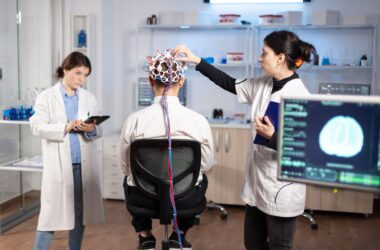Chronic diseases like diabetes and heart failure are on the rise globally, placing a significant strain on healthcare systems. Effectively managing these conditions requires constant monitoring and proactive care strategies. This is where the Internet of Things (IoT) is making a significant impact. By leveraging interconnected devices and sensors, healthcare IoT empowers care providers to collect real-time patient data, empowering them to make the right decisions and elevate patient outcomes. The global Healthcare IoT market reflects this growing demand, with a projected value of USD 4,062.34 billion by 2032, boasting a staggering CAGR of 24.3% during the forecast period of 2024-2032. This surge signifies the immense potential of Healthcare IoT to revolutionize chronic disease management and transform the future of patient care.
This blog emphasizes the rise in the demand for interconnected devices and sensors to deliver optimal healthcare outcomes.
Data Security And Privacy – Challenges & Opportunities
While Healthcare IoT offers immense benefits, data security and privacy remain paramount concerns. Healthcare data is very sensitive, and any breaches can have severe consequences for patients. Here’s a closer look at the challenges and opportunities:
Challenges
- Data Breaches: Healthcare IoT systems are complex and interconnected, making them vulnerable to cyberattacks. Hackers can unethically obtain access to sensitive patient data, leading to identity theft and even physical harm.
- Compliance With Regulations: Strict regulations like GDPR and HIPAA govern the collection, storage, and use of patient data. Healthcare providers need to ensure compliance with these regulations to prevent hefty fines and reputational damage.
Opportunities
- Blockchain Technology: As mentioned earlier, blockchain offers a secure and tamper-proof approach to storing and managing patient data. By encrypting data and creating an immutable audit trail, blockchain can significantly enhance data security.
- Focus On Patient Education: Educating patients about data privacy and security practices can promote trust and encourage them to actively participate in managing their health. By understanding how their data is used and protected, patients are more likely to embrace Healthcare IoT solutions.
Catering to these challenges and capitalizing on the available opportunities is crucial for ensuring the sustainable growth and widespread adoption of Healthcare IoT. By prioritizing data security, encouraging transparency, and empowering patients, the healthcare industry can unlock the full potential of connected care and revolutionize the way we deliver and manage health.
What Are The Key Drivers of Healthcare IoT Market Growth?
The healthcare industry is experiencing a surge in adopting Internet of Things (IoT) technologies, driven by several critical factors. Three of the most prominent factors driving healthcare IoT market growth include:
Rising Prevalence Of Chronic Diseases
Chronic conditions like heart disease and respiratory illnesses are becoming increasingly prevalent worldwide. These conditions require constant monitoring and management to prevent complications and improve patient outcomes, wherein healthcare IoT devices excel in this domain. They offer real-time data on vital signs, blood sugar levels, and other critical health metrics, enabling healthcare professionals to manage chronic conditions and intervene early if necessary. This improves patient well-being and reduces the overall burden on healthcare systems.
Growing Aging Population
The global population is aging rapidly. As people live longer, the need to effectively manage age-related health issues increases. Healthcare IoT offers valuable solutions for this growing demographic. Wearable devices can monitor activity levels, sleep patterns, and potential falls, allowing for timely intervention and improved care for elderly individuals. Additionally, remote patient monitoring systems empower healthcare providers to track the health of seniors living independently, ensuring their well-being and potentially preventing unnecessary hospital admissions.
Increasing Demand For Remote Healthcare Solutions
The COVID-19 pandemic significantly highlighted the need for remote healthcare solutions. Healthcare IoT plays a crucial role in fulfilling this demand. Remote patient monitoring systems enable healthcare professionals to track patients’ vitals and health data remotely, minimizing unnecessary hospital visits and exposure risks. Telemedicine consultations facilitated by IoT technology further enhance accessibility to healthcare, particularly for individuals in remote areas or those with limited mobility. This shift towards remote care models improves patient convenience and helps streamline healthcare resource allocation.
Top Applications of Healthcare IoT
While challenges exist, the future of Healthcare IoT is undeniably bright. Here’s how it’s transforming patient care:
- Remote Patient Monitoring: Healthcare providers can track vitals and health data remotely, minimizing hospital visits and improving care accessibility, especially beneficial for chronic conditions and at-risk populations.
- Smart Wearables: These devices enable continuous health data collection, empowering individuals to actively manage their health. They can track activity levels, sleep patterns, and even vital signs, providing valuable insights for both patients and healthcare professionals.
- Telemedicine: IoT facilitates virtual consultations, revolutionizing healthcare management, especially in remote areas or for patients with restricted mobility. This not only improves convenience but also streamlines resource allocation for healthcare providers.
- Connected Imaging: IoT streamlines medical procedures and enhances diagnostic accuracy. Real-time data transmission between imaging devices and healthcare professionals allows for faster and more informed decision-making.
AI And Machine Learning – Empowering Predictive Healthcare with IoT Devices
AI and machine learning are exceptionally transforming the capabilities of Healthcare IoT devices. By analyzing large sets of data collected from sensors and wearables, AI algorithms can identify patterns and predict potential health risks. This empowers healthcare providers to take preventive and proactive measures to elevate patient outcomes. Here are some specific examples:
- Predicting Chronic Disease Complications: AI can analyze blood sugar levels and other data from diabetic patients to predict potential complications like kidney failure.
- Identifying Early Signs Of Mental Health Issues: Machine learning algorithms can analyze sleep patterns, activity levels, and social media activity to detect early signs of depression or anxiety.
- Personalized Treatment Plans: AI can analyze a patient’s medical history, genetic data, and real-time health data to develop tailored treatment plans that are extra effective and have fewer side effects.
In Conclusion
The rise of Healthcare IoT denotes a paradigm shift in healthcare innovation and delivery. By utilizing interconnected devices and harnessing the power of emerging technologies, we are on the cusp of a future where proactive care, remote monitoring, and personalized treatment plans become the norm. This not only empowers patients to take charge of their health but also equips healthcare providers with the tools to deliver more efficient and effective care. While challenges remain, continued technological advancements and a focus on patient privacy will pave the way for a fully realized connected healthcare ecosystem. The future of healthcare is undoubtedly connected, and Healthcare IoT is at the forefront of this transformation, promising a future where better health outcomes and improved quality of life are within reach for all.
[Related Read: Revolutionizing Healthcare Supply Chain With Healthcare GenAI]












